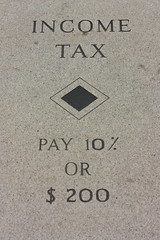I’ve gotten this question twice in the past week so I thought I’d post it on my blog:
I pay my estimated taxes out of my personal account, but really I’m paying estimated taxes for my small business, shouldn’t I take the money out of my business account?
That’s a really good question, and the answer is “It depends.” If you own a C corporation, then the answer is yes. But most of the small businesses I deal with are Sole Proprietors and Sub S Corporations; if you have one of those, the answer is NO!
Here’s why Sole Proprietors and Sub S Corporation Owners should not pay their estimated taxes out of their business accounts: All of the profits from these kinds of companies are taxable to the individual that owns them. The companies themselves pay no tax, the individual owner does. Because the owner, not the company, owes the tax, the owner must pay from his personal account.
Let’s do an example: Daisy Duke owns Daisy’s Delightful Doggie Daycare (D4). It’s basically a pet-sitting business she runs out of her home. Daisy’s pretty savvy about accounting, so she maintains a separate bank account for her business and she claims every legal deduction she’s entitled to. She runs all of her business expenses through her business account.
For the quarter, Daisy has $10,000 of income and $6,000 of business expenses. She wants to make an estimated payment on the remaining $4,000 of income. Daisy determined that she spends 40% of her net income on federal taxes so she’s going to send $1600 to the IRS. This check is not written on the D4 checking account, but instead on Daisy’s personal account.
Note that Daisy runs all of the business expenses through the business account, but because the taxes are not considered to be a business expense, they can’t go in there. If Daisy were to take her kids to Chuck E. Cheese’s for pizza, she would not pay for that out of her D4 account either. Now it’s sounds crazy equating estimated tax payments with Chuck E. Cheese’s Pizza but to the IRS’s eyes, they’re the same thing—a personal expense.
So here’s the next question that people always ask: What if Daisy doesn’t have enough money in her personal checking account to pay the taxes? That’s another good question. Remember, though, that the reason Daisy has to pay estimated taxes is because she’s making a profit. She’s got that $4,000 of profit sitting in her business bank account. She can make a payment to herself because she owns the company. She’s paying herself a draw (or maybe with an S Corp a salary), but when you own the business and you have a separate business account, you are allowed to pay yourself from the account.
Next question: But isn’t it a waste of time? Aren’t you writing two checks-one to Daisy and then one to the IRS, when writing one check directly to the IRS would solve the problem? No, it’s not a waste of time because it’s worth the extra five minutes to keep your books straight.
If you keep your business books strictly for business, with no personal expenses running through there at all, the IRS is going to think you’re pretty boring and not worth wasting much time on trying to audit you. This is one of those times where boring is good! Remember, paying your estimated taxes out of your business account is seen to be the same as taking your kids to Chuck E. Cheese’s Pizza. It’s a cheesy expense! (Sorry, that pun flew out of the keyboard, I couldn’t stop it.)
Many small business owners get into tax trouble because they wind up using their business accounts for personal spending. While your estimated tax payment seems like it would be a business expense, it’s not and you have to keep it separate.









